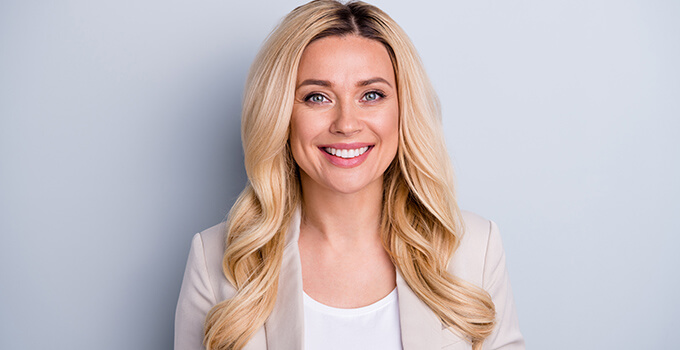
The difference between hair dye and bleach
Have you ever wondered what the difference is between dyeing your hair and bleaching your hair? Although they are both chemical treatments to lighten the colour of your hair, the resemblance ends there. We explain the differences so you can make your choice.
Hair dye is better for your hair
Dyeing is less stressful for your hair than bleaching. This is because bleaching breaks up almost all existing colour pigment in your hair. This can be your own natural colour pigment or colour pigment from hair dye. You might imagine that this is generally a more aggressive process than dyeing, which does not break up all the existing pigment in your hair, but mainly adds colour.
We explain how dyeing your hair and bleaching work slightly more thoroughly below for clarification.
Effect of a temporary hair colour
Temporary hair colouring (fades and washes out, restoring your natural hair colour) does not penetrate your hair or penetrates it less deeply. The colour pigments consist of larger molecules. These molecules remain on your hair.
With a semi-permanent hair colour, the molecules are smaller, allowing them to penetrate your hair shaft. As a result, your colour lasts for up to five washes.
Effect of permanent hair dye and bleach
Permanent blonde hair colouring (hair dye) and bleaching or lightening work in a different way. They are both permanent; this means that you cannot get your own hair colour back in your dyed or bleached hair. Both hair dye and bleach consist of two substances that you have to mix. One is an 'acid' and the other a 'base' (usually ammonia). After mixing, a chemical reaction starts.
When you apply the mixture to your hair, it swells, allowing the active substances to penetrate deeply into the hair cortex. With bleaching, the colour pigment present is then removed. In hair dyeing, pigment is broken down to a lesser extent and colour pigment is added.
Effect of bleaching
When you bleach your hair, you don't usually add colour pigments, but rather break down existing ones. The melanin ( colour pigments) in the hair shaft is oxidised, giving you colourless hair. The active ingredient in bleaching agents is hydrogen peroxide. Hydrogen peroxide decomposes into water and active oxygen. The released oxygen takes care of bleaching. The concentration of hydrogen peroxide in the bleaching agent determines the decolourisation. The longer the hydrogen peroxide is in contact with the hair, the more the decolourisation increases.
When you bleach your hair, the colour pigments in the hair are permanently broken down.
Damage to your hair from bleaching
Bleaching your hair can make it feel less soft. This is because 'bleaching' your hair changes its porosity and elasticity. If your hair is more porous, it means the hair cuticles are more open and stay open. This can result in split ends and if left untreated, your hair can even break off.
Another cause of damage is that when the bleaching chemicals enter the hair shaft, they also degrade the natural fatty acids, resulting in a weaker hair strand. With the right care and products, though, you can improve the quality of your hair a lot after bleaching. You can also limit damage by adding certain products, such as Colour Mask to your bleach.
How much lighter can you go?
Although hair dye is a lot less damaging to lighten your hair, it is not always possible to lighten your hair (enough) with hair dye. So the colour difference you can achieve with hair dye is a lot more subtle. If you have very dark hair, you usually have to use bleach.
With hair dye you can, in the most optimistic case, lighten up to four colour levels. How light or how blonde you can dye your hair depends on four things:
- whether your hair is dyed, dyed hair can not be lifted with hair dye, only with bleach.
- the colour level of your own hair.
- Black and dark brown: Do you have black or very dark brown hair? You can't lighten that with hair dye, but you can with bleach.
- Brown and light brown hair: From colour level five, you can dye your hair one colour level lighter.
- Blonde hair: Do you have dark blonde or lighter blonde hair (colour level 7 or higher)? Then you can lighten your current, undyed hair with dye by several colour levels, again depending on the dye and hydrogen peroxide you use. For this, consult the specific hair dye you would like to dye with.
- the kind of hair dye you use.
- the percentage of hydrogen peroxide you use with this dye.
Unsure which (blonde) hair dye colours are feasible on your hair? Complete the questions about your hair in our hair colour advice tool. Then see how light you can go.
The processing time
On the packaging of hair dye or in the instructions of use, there is always a standard processing time indicated. This is convenient; after the recommended time, the colour will be at its best and become perfect as intended!
With bleaching, there is no standard processing time. The processing time depends on your own hair colour, hair structure and preference. You have to keep checking in between to see if the colour of your hair is already to your satisfaction. Then rinse and wash your hair as soon as possible to remove the damaging bleaching effect. Follow the instructions for use for this, of course.
So you do not know in advance which processing time will give you the best results. And actually, this is why you have to work faster, because bleaching usually has a shorter processing time than hair dye.
Also, because bleaching is a lot more damaging to your hair, there is a maximum application time. Also, the shorter in your hair, the less damaging.
Bleach or hair dye?
First, ask yourself if you can achieve the desired result with hair dye as well. Is that achievable? Then it is better to dye your desired colour.
Do you rely on bleaching for your hair colour? Then first find out for yourself whether your hair is healthy enough. Is your hair in bad condition? Then do not bleach. Because bleaching (however 'mild') affects the condition of your hair, already damaged hair may even break.
Do you want to bleach? Then be sure your hair is in good condition. If this is not the case, it is better not to expose your hair to bleach.
How do you know if your hair is healthy enough for bleaching?
You can probably also tell with the naked eye if your hair is healthy. Healthy hair:
- is shiny;
- is elastic (curls stay in shape);
- doesn't fall out;
- detangles easily;
- is not immediately frizzy with humidity;
- doesn't break.
Still in doubt? Then test the degree of porosity of your hair. Take a hair. Place it in a glass with water. Does the hair float? Then your hair is in good condition. Does your hair immediately sink to the bottom? Sinking your hair indicates severely damaged strands. Damaged and therefore porous hair can absorb more moisture and sink.
Make sure your hair is in good condition by taking good care of it.
The difference between hair dye and bleach
So there are many differences between dyeing and bleaching your hair. The effect, processing time and results are very different. But the biggest difference between dyeing and bleaching is that bleaching is much more damaging for your hair, so you need to know what you are doing. And you can't dye dark or coloured hair lighter, you have to bleach.
